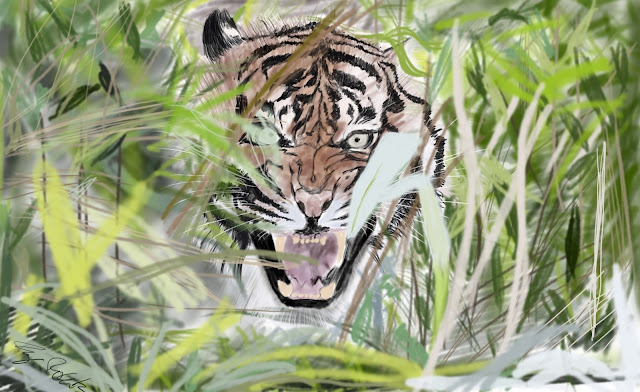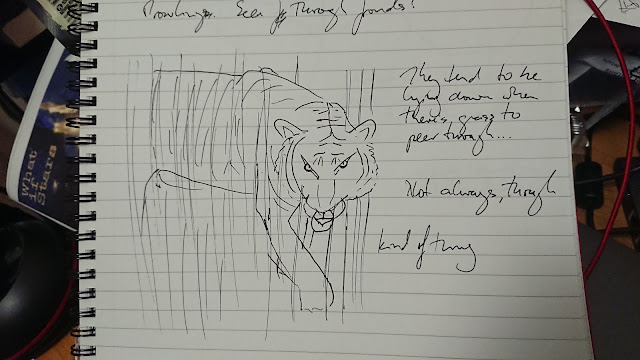For once I’m not going to start with the poem this artwork is related to – in fact, I might not even include it at all in this post. We’ll find out by the end of the article, I guess…
You see, for one thing: it’s long. It takes up a whopping six pages in the current draft of Spectral, seven with the illustration. It’s the second longest piece in the book and will take up quite the chunk of time in the audiobook.
For another thing: it’s intense. And really, trust me – you don’t want to start your day reading that.
So I guess I’ll talk around it a little more while I decide. ACTH was written in November 2018. I couldn’t tell you what prompted me to write it – maybe I’d been waiting to write it for a while. It’s basically a (slightly) edited stream-of-consciousness about the process of not only having a panic attack or meltdown, but also how everything gets so much worse when someone is trying to get you to analyse and describe (and explain) your own feelings. Feelings which are huge and frankly monstrous, and out of your control but also very much a part of you.
If you’d like to back away from this post right now, no blame to you, fair play. At some point I’m going to have to turn it into a recording, and that’s going to be an interesting experience (I’ve only performed it three times or so, and each time I’m flushed and out of breath afterward).
This is not a comfortable or comforting poem (unless it helps you achieve a kind of catharsis, or merely makes you feel less alone, in which case I’m very glad for you), and it’s deliberately messy and difficult, as I take the stammer which deepens, when trapped in one of these spirals, into an ice-hot knot, an impossibly large glottal stop, and transcribe it over six pages of halting lines, some of which don’t even have letters in them, let alone words.
I wrote this poem in an Allographic Write-In, back when they took place in 3D space and hugs were a possibility. And it’s named as it is because I did my physiology and psychology degree back in the last century when we called serotonin 5-hydroxytryptamine (5-HT), and we learned about stress responses and the particular pathway governed by adrenocorticotropic hormone or ACTH, which I always get mixed up with acetylcholine, ironically enough. (Or maybe that was when I was teaching it to A Level students in 2003 and I had them act out the stress pathway by embodying different body parts passing notes to each other to stimulate other notes to be passed on to the next fidgeting organ… hard to say…) And titles are my least favourite part of the creative process, so a working title generally sticks around because it’s better than nothing. So behold: I Googled the hormones and neurotransmitters involved in a panic attack and discovered that there are a lot, including serotonin and dopamine (which surprise is part of the rationale for placing this piece at the end of the Anger section, which then leads into Joy), and we had a permanent working title.
Anyway, the thing about scribbling in a small notebook in a hurry when you have handwriting like mine is that all sorts of misapprehensions can occur, which led to this part:
… because I’m –carrying tigers
–t-ti– tight-wound into s-tubborn synapses;
I ssee them in the shape of certain smiles,
hear their growls in heavy footsteps, slammed doors,
all the other exhortations of a –twitching,
un– ttrustworthy world.
I couldn’t tell you now which word I misread as tigers, but I liked it, so on went the stanza into that extended metaphor.
When I was choosing illustrations for the book, I knew really early on that I wanted a tiger. Moreover, I wanted one moving through undergrowth, menacing the viewer.
Google image search brought something much more electrifying than my original, almost languid sketch (see end of post), but frustratingly, gave no clue as to the original photographer. Reddit, of all places, bounced me to the possible source, so, unless anyone knows any different, that’s who I’ll credit.
 |
| Source: Probably wildlife photographer Michael Nichols. One of the things that intrigues me is that I can’t tell whether this creature is exhibiting fear or rage. And that’s why it’s illustrating this poem… |
There are fourteen visible layers to this piece (I may have overthought somewhat), plus another three for guidance, where I sketched the outline, and some of the important placements, like the stripes which seemed more significant to me at the time (and the more visible ear, which I apparently put in way too low, somehow). The learning curve for producing these has been steep, and this particular piece nearly saw me throwing the towel in; I’m really glad I persevered, even though it’s not quite as gloriously saturated as the Tyger of the glossy, childhood book I can still see, feel, and smell, with very little provocation. It’s possible that the publisher won’t be able to make much of the greyscale version of this; I’m looking forward to that discussion!
(And no, I didn’t know when choosing illustration concepts that 2022 was the Year of the Tiger… but I do now!)
Looks like I’m not giving you the whole poem this time after all. Instead, here is the concept sketch, complete with scribbly notes, and the initial outline of the final piece. Next time we’ll either be delving Philosophy & Mysticism, or Melancholy. Depends what I manage to do… Thanks for reading!


No comments:
Post a Comment
Thanks for commenting.